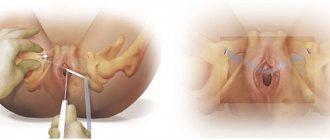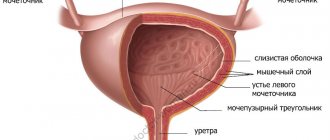December 21, 2021 Urinary incontinence or incontinence is a common problem not only in preschool children, but also in adults. The main symptom is uncontrolled leakage of urine. You may also experience a feeling of a full bladder, involuntary sudden release of a small amount of urine when sneezing or laughing, and unexpectedly strong urges.
This condition in itself is not dangerous to health, but it brings great discomfort and worsens the quality of life. Sometimes the problem can be solved by performing special exercises to improve urination. It is strongly recommended to consult a urologist, since incontinence may indicate the presence of certain pathologies of the genitourinary system.
How to train your pelvic floor muscles
First you need to figure out where they are and how to strain them. Try to stop the flow of urine while urinating, without squeezing the muscles of the abdomen, buttocks and thighs. You can do this using the pubococcygeus muscle. It is precisely these contractions that are needed in exercises for better urination. You may not be able to immediately understand how the pelvic floor muscles work. Try again and again, remembering how you feel. When performed correctly, men experience twitching of the penis and testicles, and women experience a feeling that the vagina is narrowing.
In the first stages, do Kegel gymnastics in a calm environment, concentrating on the process, repeating each exercise 5-10 times. You can take various poses during exercise, in which the muscles will be activated in different ways: lying on your back with your knees bent, straightening each leg in turn, lying on your stomach, in the “gluteal bridge” position.
Alternate the following exercises to improve urination in men and women:
- to increase endurance, contract the pubococcygeus muscle at a fast pace, holding it tense for 1-2 seconds and relaxing;
- slow tension and quick relaxation will improve control over the “intimate” muscles;
- Tighten your pelvic floor muscles for 10 counts and relax them just as slowly.
During gymnastics, you should not hold your breath. For maximum effect, tense your abdominal and pelvic floor muscles at the same time, gradually increasing the number of repetitions up to 30 times in one approach.
Once you practice regularly and understand the principle, Kegel exercises for urinary incontinence can be done without anyone noticing, anytime, anywhere.
Pharmacies Pharmakon
Strengthening the pelvic floor muscles
The pelvic floor muscles act as straps to hold the bladder
and its cervix are suspended, and also form the external sphincter.
If these muscles weaken, the pelvic organs drop down, leading to urinary incontinence
.
Before you begin doing exercises to strengthen your pelvic floor muscles
(Kegel exercises), you need to correctly identify these muscles. To do this, you need to voluntarily stop the process of urination. Regular Kegel exercises (contraction of the pelvic floor muscles with delayed release) can strengthen the pelvic floor muscles and reduce urine output for stress and urge incontinence. These exercises should be performed daily in different body positions: sitting, standing and lying down, repeating 5 times in a row, holding each contraction for a count of 1-5, while only the pelvic floor muscles should be tensed, without involving the abdominal muscles and thighs in this process . Exercises can be done at a desk, while driving, while reading or watching television. The effect of daily exercise is possible no earlier than 2-3 months.
Bladder training
For urge urinary incontinence, exercises aimed at strengthening the pelvic floor muscles can also be used to “retrain” the bladder. At the moment of contraction of the external sphincter, signals are given to relax the bladder, thus, the imperative urge to urinate is gradually blocked. Every time you feel the urge to urinate, try to stop the feeling by contracting your pelvic floor muscles. Try to hold this contraction a little longer than the previous one. You will feel improvement in 2-3 weeks.
Diet for urinary incontinence
Certain foods can irritate the bladder, so it's best to avoid them if you have urinary incontinence. These include carbonated and caffeinated drinks, alcohol, citrus fruits and juices from them, spicy foods, artificial sugar substitutes. To avoid dehydration, you need to drink enough liquid. Limiting fluid intake can irritate the bladder and increase urinary incontinence.
Drug therapy for urinary incontinence
The prescription of pharmacological drugs depends on the type of urinary incontinence and the causes that caused it. For overactive bladder, medications can reduce the incidence of urinary incontinence, the frequency and urgency of urination, and increase the volume of urine produced. Modern medicines are effective and safe. In case of estrogen deficiency, estrogen replacement therapy is prescribed; if urinary incontinence is caused by infection, antibiotics are prescribed.
Surgery
If therapeutic methods are ineffective for stress urinary incontinence, surgical treatment is sought. The type of surgical intervention depends on the type of urinary incontinence, the severity of the condition, as well as the general well-being of the patient.
Exercises to train the pelvic muscles
These exercises are a special type of gymnastics aimed at strengthening the tone of the pelvic muscles.
.
Pelvic muscles
- muscles that carry and support internal organs. They participate in the process of emptying the bladder, opening and closing the lumen of the urethra. Weakened pelvic muscles cannot fully perform their functions, which leads to unwanted urine output.
Pelvic muscles
able to voluntarily contract and relax. When urinating, you can feel the work of these muscles. After emptying the bladder, after a short period of time, the pelvic muscles relax. And it is this muscle group that the training will focus on.
The breathing process is in close interaction with the pelvic muscles. When you inhale, the chest increases in size, and accordingly, the volume of the abdominal cavity decreases. At the same time, the pressure on the pelvic muscles increases.
Warm-up to relax the pelvic muscles
Before starting the exercises, it is recommended to do a warm-up aimed at relaxing the muscles of the pelvic floor. This is achieved by moving the pressure force in the pelvis. Duration approximately 5 minutes.
While kneeling, bend your upper torso forward. Focus on your forearms. Place your head on your hands.
Exercises for the pelvic muscles
These exercises increase the tone of the pelvic muscles.
Please maintain proper breathing while performing the exercises. Inhale - The pelvic muscles are relaxed. Exhale - the muscles contract. Perform each exercise as many times as you want.
1) While standing, sitting or lying down, cross your legs. As you exhale, try to move your feet away from each other.
2) Sit on a hard chair, round your back. Concentrate on the pelvic area. As you exhale, tense your anus muscles.
3) The contraction of the muscles in the pelvic area can be better felt by doing the following exercise: place a roller between your legs (you can make it from a towel), squat on it, taking a rider’s position. As you exhale, tense your muscles. As you inhale, relax.
When tense, the pelvic muscles contract and are pulled into the pelvic area. When relaxed, the muscles become soft and lower. Try to do the exercises regularly, preferably daily. The more frequent and intense the training, the more effective it is.
Consulting addresses:
1. Izhevsk, st. Kirova, 109, tel.
Opening hours: 8.00 - 23.00 without lunch and weekends
2. Izhevsk, st. Likhvintseva, 46, tel.
Opening hours: 8.00 - 24.00 without lunch and weekends
Back to section
Additional benefits of intimate muscle training
In addition to the benefits of Kegel exercises for urinary incontinence in women, they are beneficial for the health of various systems and the body as a whole. In particular, we are talking about sexual health. If a representative of the fairer sex notices weakened tone of the vaginal muscles (or her partner notices this), wants to improve the quality of sensations received during intimacy, or increase libido, you need to start training immediately. Thanks to regular training, the tone of the pelvic muscles will increase and blood circulation in this area will improve (which is important for those whose activities involve being in a static position for a long time). A woman will be able to control her intimate muscles, which will expand the range of sexual sensations, give joy from intimate caresses and increase libido.
Kegel exercises will also bring significant benefits to those entering the menopause phase. During this period, sexual intercourse can cause discomfort and pain, and the external genitalia are not sufficiently moisturized. If we add to this the increased likelihood of ureteral infections, the picture is bleak. The sooner you start gymnastics, the faster you can eliminate problems. Thanks to regular training, blood circulation will improve, and with it the condition of the mucous membranes. The risk of skin damage during sexual intercourse will decrease, which means the likelihood of infection will decrease. At the same time, the muscular tissue of the genitourinary system will be strengthened, which will prevent incontinence.
Features of classes for women over 50
Women who have celebrated their anniversary should not consider themselves pensioners and give up intimate life. With age, the muscles of the vagina lose their tone, and the pressure of the uterus on the bladder often provokes incontinence. If you supplement the sensations with manifestations of menopause, the picture is not rosy. There is a solution to the problem: thanks to Kegel gymnastics for women, you can restore muscle tone at any age, eliminate discomfort, and prevent diseases of the pelvic organs. It will take longer to practice until you get the desired result than in your youth, but the effect will be there.
The right approach
Experts give the following recommendations on how to properly perform Kegel exercises for women:
- empty your bladder immediately before class;
- choose a comfortable position - sitting, lying or standing. If the preferred position is lying on your back, your arms should be extended along the body and your knees slightly raised. The neck should not be strained;
- The main movement in any Kegel exercise for women is compression (contraction). It is important to avoid tension in the abdominal muscles, buttocks and thighs, otherwise there will be no result;
- you need to breathe deeply, evenly and calmly, without delay;
- you cannot contract the intimate muscles when urinating - this method, on the contrary, weakens the pelvic floor muscles;
- repeat the complex 3-4 times during the day, performing 5 to 40 repetitions each time. You cannot sharply increase the load, only gradually: perform 15 repetitions for 2 weeks, 20 repetitions for the next 2 weeks, etc.
The correct technique for performing Kegel gymnastics for women allows you to feel the first positive results after just six weeks of regular exercise. Changes will be noticeable in all areas of life, including intimate ones, and self-confidence will even increase.
The benefits of Kegel exercises for incontinence
The muscle fibers of the pelvic floor form a kind of hammock at the base of the pelvis. Their task is to fix and strengthen bone tissue, hold the bladder, urethra, intestines, uterus and maintain their functionality. The weakening of these muscles is associated with various reasons. This could be overweight, genetics, persistent constipation, menopause, excessive exercise and much more.
Whatever the reason for weak muscles, Kegel exercises for women are specially designed to strengthen them. The only condition is regularity and correct execution. You need to train until the pelvic muscles learn to reflexively contract in response to increased intra-abdominal pressure. This reflex will prevent involuntary leakage of urine.
So, it is advisable to do Kegel exercises for urinary incontinence in women if:
- urine is released when coughing or sneezing, laughing and physical activity, as well as during intimate relationships;
- when playing sports you have to wear urological pads;
- muscles weakened after pregnancy and childbirth;
- I am unable to hold urine when there is an urgent urge.
In these situations, Kegel exercises will help strengthen the muscles of the genitourinary organs, and the problem will be solved quickly and effectively.








